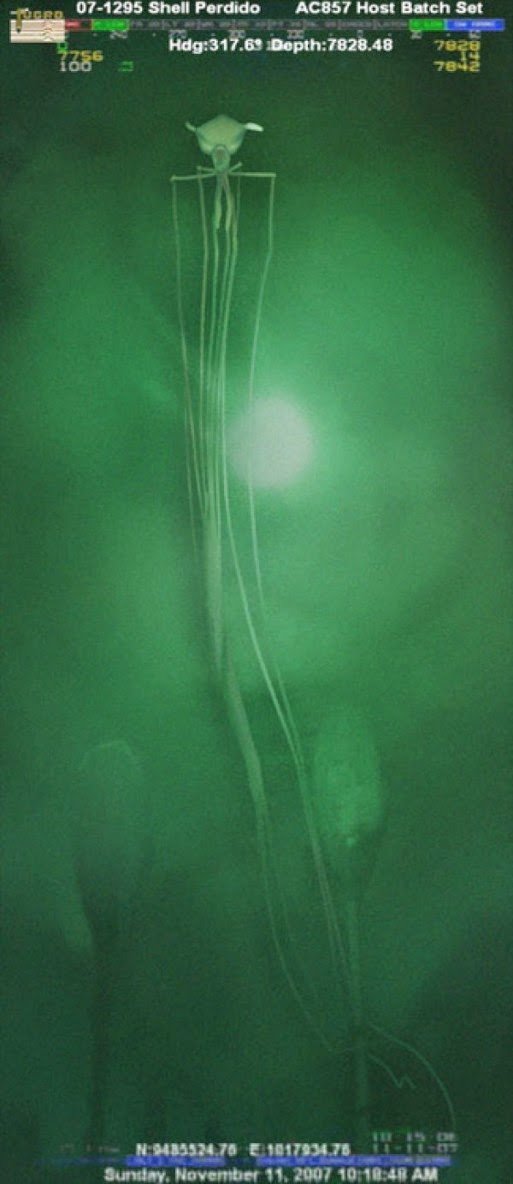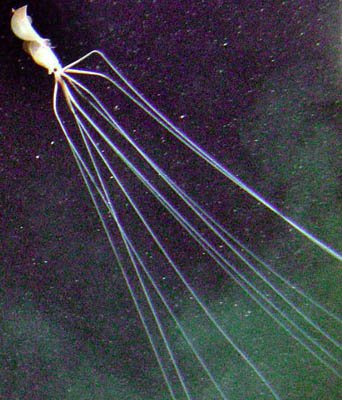Welcome to another post of my strange animals series where you get to meet some of the weirdest, coolest, and craziest animals on a daily basis!
Remember the creepy aliens from Independence Day? It's ok if you don't, cause today I have for you a creepy deep sea monster that will jog your memory:

Think that's all? Let's zoom out a bit!

(credit for both photos: Shell Oil)
Meet the big-fin squid, an elusive and terrifying cephalopod for which very little is known. The monster pictured above was spotted in the Gulf of Mexico, about 2.500 m below surface by a ROV, on 11 November 2007, off Perdido, a drilling site owned by Shell Oil Company.
And lucky for us, Shell has released a video showing the monster in all its' glory:
The interesting thing about Bigfin squids is that we have never managed to get a specimen in our hands! For now, it is assumed that they belong to the genus Magnapinna and the family Magnapinnidae, a group of animals known only from larval, paralarval, and juvenile specimens. With no specimen to examine or sample, there is no way to confirm if they belong to the same genus or are just distant relatives. [1,2]

(credit, public domain)
Now, let's learn more about these mysterious animals.
Bigfin Sightings
Here's a quick breakthrough of confirmed Bigfin sightings as of today:
- September 1988: The crew of the submersible Nautile encounters a long-armed squid off the coast of northern Brazil, at a depth of 4,735 meters.
- July 1992: The Nautile encounters again two individuals, one off the coast of Ghana at a depth of about 3,000 meters and one off Senegal at 2,950 metres.
- November 1998: The Japanese manned submersible Shinkai 6500 encounters and films an individual in the Indian Ocean, south of Mauritius at a depth of 2,340 meters.
- January 2000: The oil-drilling ship Millennium Explorer records a bigfin squid, at Mississippi Canyon in the Gulf of Mexico at 2,195 metres.
- May 2000: The ROV Atalante films an individual in the area of Rodrigues Island at 2,576 meters deep.
- October 2000: The manned submersible Alvin meets another long-armed squid at 1,940 meters in Atwater Valley, Gulf of Mexico.
- May 2001: ROV Tiburon videotapes an individual north of Oahu, Hawaii at 3380 meters deep.
- November 2007: ROV captures footage of a long-arm squid off Perdido, a drilling site owned by Shell Oil Company, located 200 statute miles (320 km) off Houston, Texas in the Gulf of Mexico.
And that's it! In all these years that we have been exploring the oceans, there have been less than 10 reported sightings! Here's a link if you want to learn more details about these sightings, like the exact coordinates and the size of some of the individuals.
And here's a compilation video, with footage from some of these missions. Hope it doesn't give you any nightmares:
Tell Me More About Bigfin Squids!
Unfortunately, there is not much too tell. As aforementioned, we have never had the chance to examine or sample a bigfin. Other than how they look like, the little we now is based on the assumption that they are the adult form of Magnapinna squids, for which we also know very little about! Here's a quick breakdown of what we know:
- Distribution: Sightings have been reported in the Atlantic Ocean, Indian Ocean, Gulf of Mexico, and Pacific Ocean.
- Morphology: These squids have remarkably large and elastic arms and tentacles (duh!) of about equal size, winning them the nickname "long-arm squids". Both appendages are held in an unusual position, extending at sharp angles to the body axis then abruptly (sometimes at a 90° angle) turn anteriorly, giving the appearance of strange "elbows". These elbows are, roughly, two thirds of the length of the mantle away from the body axis. The elastic tentacles have been estimated to be 15 to 20 times the mantle length when stretched, while estimations based on video footage place the maximum total length of these unusual squids to at least 8 meters. [1]
- Diet: Nobody really knows.. Some assume bigfin squids feed by dragging their arms and tentacles along the ocean floor, feeling and grabbing any edible organisms they touch. Alternatively, they may be sit-and-wait predators, waiting passively for prey to fall into their arms.
- Species: There are 5 discovered Magnapinna species. They all look very similar and they are only described from juvenile specimens. Click here if you want to learn more about the small physiological differences amongst the various species along with some other technicalities.

Holotype of Juvenile Magnapinna atlantica (credit)
The End
And that's pretty much all we know about bigfin squids! Until we catch an adult specimen, dead or alive, there's only so much ROV footage can reveal to us. Hopefully, one day we will learn more about them. In the meantime, enjoy one more beautiful video of this magnificent creature:
References
- Wikipedia.org/wiki/Bigfin_squid
- Tolweb.org/Magnapinna
- Eol.org/pages/3020457/details
- Invertebrates.si.edu/cephs/vetal01/vetal01.html

My dear readers, thank you for reading today's article. Hopefully, you found it interesting enough to follow me, @trumpman. You may also want to check my strange animal series where you get to discover some of the world's weirdest animals! Here are the last 5 weirdos of that series:
- 9 Incredibly Weird Animal Penises !!!
- Beauty Stings #2 - The Wattle Cup Caterpillar
- Leptodirus hochenwartii: The First Cave-Dwelling Animal Ever Discovered
- Paedophryne amauensis: Meet the World's Smallest Frog
- The King of Herrings: Horrifying, yet Harmless
Steemstem & Steemiteducation
Interested in science? Please, don't forget to check the @steemstem, a community-driven project meant to promote well-written, high-quality, STEM-related content (STEM as for Science, Technology, Engineering and Mathematics). Just click here to join us!
Also a big thank you goes to the @steemiteducation project for liking and sharing my content. Thanks guys!
Greek Community
Another big thanks goes to my fellow greeks who support me with their love! You guys rock! A special mention also goes to @rouketas and @skapaneas for bringing us all together! I love you guys all :)



